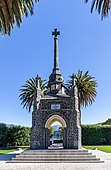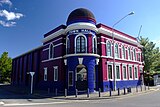| Henry MurrayMC | |
|---|---|
| Born | (1886-01-14)14 January 1886 Christchurch, Colony of New Zealand |
| Died | 12 April 1943(1943-04-12) (aged 57) |
| Alma mater | Christ's College |
| Spouse |
Ismene Nola Simms (m. 1916) |
| Relatives | Toby Murray (cousin) |
Henry St Aubyn Murray MC (14 January 1886 – 12 April 1943) was a New Zealand architect and athlete.
Biography
Murray was born in Christchurch, New Zealand, in 1886. He received his education at Christ's College. All Black Toby Murray was his cousin. After school, he went to the local architect Frederick John Barlow as an apprentice.
Murray was the New Zealand champion hurdler from 1906 to 1910, over 440 yards. He finished third behind John Duncker in the 120 yards hurdle event at the British 1908 AAA Championships.
He competed for Australasia in the 1908 Summer Olympics in London, England. He competed in two athletic events. In the 110 metres hurdles he was second in the heat (16.3). In the 400 metres hurdles he was second in the heat (59.8). As the heats were held as sudden death events, he did not qualify. He is listed as New Zealand Olympian number 2 by the New Zealand Olympic Committee.
He married Ismene Nola Simms on 5 April 1916 in Brisbane. She was the daughter of H. G. Simms from Londo,n who had lately lived in Christchurch. From later that year, Murray served with the 11th Field Company of the Royal Australian Engineers in WWI. In 1917, he won a Military Cross for bravery. The citation reads:
On 4th October 1917, E. of Ypres, this officer was in charge of a party of sappers and attached Infantry during operations with instructions to construct two strong points in rear of the final objective. He successfully led his men to the positions in spite of an enemy barrage fire. Not only did he carry out his instructions constructing and wiring strong points, but he also re-organised scattered parties of men he came across during operations, and by his coolness under fire and good work, was a source of inspiration and encouragement to all in his vicinity.
As an architect, Murray undertook many commissions for the Catholic Church. His best-known work in the Church of the Holy Name in Ashburton, which is registered by Heritage New Zealand as a Category I historic structure. The two other buildings designed by him that are registered by Heritage New Zealand, both as Category II, are the Scottish Hall in Invercargill and the Rangiora Town Hall. Another notable structure that he designed is the Akaroa War Memorial.
Murray was a flying officer in the Royal New Zealand Air Force during WWII. On Saturday, 10 April 1943, he was in a jeep that skidded on loose gravel near Whangarei Harbour and overturned. He died from his injuries early the following Monday morning, aged 57. Murray's funeral was held at St Mary's Catholic Church in Central Christchurch and he was buried at Ruru Lawn Cemetery in Bromley.
Buildings and structures designed by Murray-
 Akaroa War Memorial, designed in 1921
Akaroa War Memorial, designed in 1921
-
 The Town Hall in Rangiora, designed in 1925
The Town Hall in Rangiora, designed in 1925
-
 Church of the Holy Name in Ashburton, designed in the early 1930s
Church of the Holy Name in Ashburton, designed in the early 1930s
References
- "Henry Murray". Olympedia. Retrieved 9 March 2021.
- ^ Evans, Hilary; Gjerde, Arild; Heijmans, Jeroen; Mallon, Bill; et al. "Henry Murray". Olympics at Sports-Reference.com. Sports Reference LLC. Archived from the original on 18 April 2020. Retrieved 11 May 2017.
- Palenski, Ron (2004–2008). Black Gold. New Zealand Sports Hall of Fame. p. ?. ISBN 0-473-08536-4.
- ^ "Church of the Holy Name (Catholic)". New Zealand Heritage List/Rārangi Kōrero. Heritage New Zealand. Retrieved 11 May 2017.
- ^ "Soldier sportsman". Auckland Star. Vol. LXXIV, no. 87. 13 April 1943. p. 5. Retrieved 20 March 2020.
- "AAA Championships". Birmingham Daily Gazette. 6 July 1908. Retrieved 25 August 2024 – via British Newspaper Archive.
- "AAA, WAAA and National Championships Medallists". National Union of Track Statisticians. Retrieved 25 August 2024.
- ^ "Henry Murray". New Zealand Olympic Committee. Retrieved 21 March 2020.
- "Marriages". The Brisbane Courier. 26 April 1916. p. 6. Retrieved 21 March 2020.
- "Henry St Aubyn Murray". Australian War Memorial. Retrieved 10 May 2017.
- "Lt. Henry St Aubyn Murray" (PDF). Australian War Memorial. Retrieved 10 May 2017.
- "Scottish Hall". New Zealand Heritage List/Rārangi Kōrero. Heritage New Zealand. Retrieved 21 March 2020.
- "Town Hall". New Zealand Heritage List/Rārangi Kōrero. Heritage New Zealand. Retrieved 21 March 2020.
- O'Connor, Paul (2011). The glorious dead: the Banks Peninsula war memorial. Christchurch: Banks Peninsula War Memorial Society.
- "Fatally injured : Airman in a jeep". Auckland Star. Vol. LXXIV, no. 86. 12 April 1943. p. 4. Retrieved 21 March 2020.
- "Capsized jeep : Whangarei accident". The New Zealand Herald. Vol. 80, no. 24557. 13 April 1943. p. 2. Retrieved 21 March 2020.
- "Funeral notices". The Press. Vol. LXXIX, no. 23924. 16 April 1943. p. 8. Retrieved 21 March 2020.
External links
| 1908 Australasian Olympic team | |
|---|---|
| Athletics | |
| Boxing | |
| Diving | |
| Rugby union | |
| Shooting | |
| Swimming | |
| † New Zealand nationals | |
- 1886 births
- 1943 deaths
- People educated at Christ's College, Christchurch
- Athletes from Christchurch
- New Zealand male hurdlers
- Royal Australian Engineers officers
- Military personnel from Christchurch
- Olympic athletes for New Zealand
- Athletes (track and field) at the 1908 Summer Olympics
- 20th-century New Zealand architects
- New Zealand recipients of the Military Cross
- Burials at Ruru Lawn Cemetery
- Australian military personnel of World War I
- Australian recipients of the Military Cross
- Royal New Zealand Air Force personnel
- New Zealand military personnel killed in World War II
- Road incident deaths in New Zealand
- Olympic athletes for Australasia